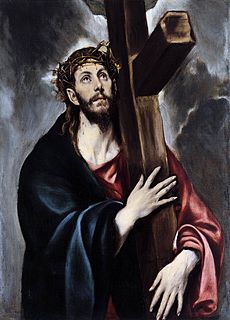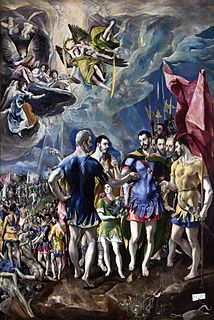 W
WAllegory to the Element Earth is a painting by the Venetian Renaissance artist Leandro Bassano of about 1580, now in The Walters Art Museum, Baltimore.
 W
WThe Bean eater is a painting by the Italian Baroque painter Annibale Carracci. Dating from 1580–1590, it is housed in the gallery of Palazzo Colonna of Rome.
 W
WThe Burial of the Count of Orgaz is a 1586 painting by El Greco, a prominent Renaissance painter, sculptor, and architect of Greek origin. Widely considered among his finest works, it illustrates a popular local legend of his time. An exceptionally large painting, it is divided into two sections, heavenly above and terrestrial below, but it gives little impression of duality, since the upper and lower sections are brought together compositionally.
 W
WButcher's Shop is the title of two paintings by the Italian Baroque painter Annibale Carracci, both dating from the early 1580s. They are now in the collections of Christ Church Picture Gallery, Oxford, and the Kimbell Art Museum in Fort Worth, Texas.
 W
WCephalus and Procis is a 1580s painting by the Italian Renaissance painter Paolo Veronese. It is on display in the Musée des Beaux-Arts of Strasbourg, France. Its inventory number is 634.
 W
WChrist Carrying the Cross is an oil painting by El Greco, produced early in his Toledo period circa de 1580. The picture depicts Christ in a moment of personal reflection as he carries the cross to his death, therefore committing the ultimate sacrifice for humankind. In the painting, Christ's eyes are lifted up to the heavens as he begins his walk towards his crucifixion. His gentle hands wrap around the cross as a stormy night floods the background. Christ Carrying the Cross is an oil painting, 105x79cm. The painting, one of numerous similar paintings by El Greco, is currently in the El Greco room in the New York art collection of the Metropolitan Museum of Art.
 W
WThe Corpse of Christ is a painting by the Italian Baroque master Annibale Carracci, dating to c. 1583-1585 and housed in the Staatsgalerie of Stuttgart, Germany.
 W
WThe Disrobing of Christ or El Expolio is a painting by El Greco begun in the summer of 1577 and completed in the spring of 1579 for the High Altar of the sacristy of the Cathedral of Toledo, where it still normally hangs. In late 2013 it was on temporary display at the Prado in Madrid, following a period of cleaning and conservation work there; it was returned to Toledo in 2014. It is one of El Greco's most famous works. A document dated July 2, 1577 which refers to this painting is the earliest record of El Greco's presence in Spain. The commission for the painting was secured thanks to El Greco's friendship from Rome with Luis, the son of Diego de Castilla, the dean of the Cathedral of Toledo. De Castilla senior also arranged El Greco's other major commission, on which he worked simultaneously, the paintings for the Toledan church of Santo Domingo el Antiguo.
 W
WThe Finding of Moses is a c.1582-1598 oil on canvas painting attributed to Paolo Veronese or produced by his studio, now in the Galleria Sabauda in Turin.
 W
WThe Gallery of Maps is a gallery located on the west side of the Belvedere Courtyard in the Vatican containing a series of painted topographical maps of Italy based on drawings by friar and geographer Ignazio Danti.
 W
WHoly Face of Jesus is a 1586-1595 painting by El Greco of the Holy Face of Jesus on a veil. It is now in the Museo del Prado, which acquired it in 1944 using funds from a legacy from the conde de Cartagena.
 W
WThe Immaculate Conception with St John the Evangelist is a c. 1585 oil on canvas painting of the Immaculate Conception by El Greco.
 W
WLucretia is a painting by Paolo Veronese from c. 1585.
 W
WThe Martyrdom of Saint Maurice is a 1580-1582 painting by El Greco in the Real Monasterio de San Lorenzo de El Escorial near Madrid.
 W
WThe Nobleman with his Hand on his Chest is an oil painting by El Greco.
 W
WRetrato de un médico is an oil painting by the El Greco.
 W
WPortrait of a Nobleman is a c.1586 oil on canvas portrait by El Greco, originally hung in the Quinta del Duque del Arco in Royal Palace of El Pardo in Madrid but now in the Museo del Prado. Its subject is unknown.
 W
WPortrait of a Young Man is a late 16th-century three-quarter length portrait painting of an unidentified young nobleman, possibly from the House of Della Rovere and the court of Pesaro, Italy. It is one of the relatively few portrait paintings by the precursor of Baroque painting, Federico Barocci. The work is now in the Musée des Beaux-Arts of Strasbourg, France. Its inventory number is 1658.
 W
WPortrait of Rodrigo Vázquez de Arce is an anonymous copy of a lost 1587-1597 painting by El Greco. It is now in the Museo del Prado in Madrid. It shows Rodrigo Vázquez de Arce, president of the Council of Castille, who also features in the same artist's The Burial of Count Orgaz. Although it is different from other portraits by the artist, it still shows the strong influence of Titian and Tintoretto, who he had met in Venice.
 W
WSaint Anthony Preaching to the Fish is a 1580–1585 oil on canvas painting of Anthony of Padua by Paolo Veronese, now in the Galleria Borghese in Rome. Its original location is unknown, though its medium dimensions of 104 centimetres (41 in) by 150 centimetres (59 in) mean it may have been painted for the side wall of a chapel or as part of a cycle of paintings for a small school (scuola) somewhere in Veneto. It entered the collection of Cardinal Scipione Borghese as a 1607 gift from Francesco Barbaro.
 W
WSaint Peter and Saint Paul is a 1587-1592 painting by El Greco, one of several versions of the theme by the artist - others are now in Barcelona and Stockholm. It shows the apostles saint Peter and saint Paul. The work was once shown on a stamp produced by the USSR.
 W
WThe Tears of Saint Peter or Penitent Saint Peter is a 1580-1589 painting by El Greco, now in the Bowes Museum in Barnard Castle, UK. It shows Peter the Apostle weeping after his betrayal of Jesus.
 W
WThe Tears of Saint Peter or Penitent Saint Peter is a c.1587-1596 painting by El Greco. It is similar to other works on the same subject by the artist, such as those in the Bowes Museum, the El Greco Museum, the national museum in Stockholm and others.
 W
WVenus and Adonis is a painting by the Italian late Mannerist artist Paolo Veronese, executed in the early 1580s, now in the Museo del Prado in Madrid.
 W
WThe Vision of Saint Eustace is a painting by Annibale Carracci, showing saint Eustace and his vision of a crucifix between the horns of a stag whilst out hunting. The saint is set in one of the first landscapes by either of the Carracci brothers, showing how he was influenced by Venetian landscape painting until about 1598 after a stay in the city in 1587 and 1588. Specific influences include Titian's Penitent Saint Jerome (Louvre) and the naturalism of Jacopo Bassano. Critics argue the composition is based on two prints by Cornelis Cort, a Flemish printer - Penitent St Jerome and The Vision of Saint Eustace. These prints were in turn based on ideas by the Lombard painter Girolamo Muziano, who was also influenced by Venetian models. The dogs and some other details are drawn from Saint Eustace, an engraving by Albrecht Dürer of the same subject.